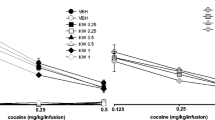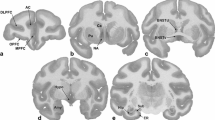Abstract
Rationale
We have recently found that blockade of dopamine D1-type receptors in the ventral tegmental area reduces the rewarding effects of intravenous cocaine; here, we explored the possibility that blockade of D1 receptors in the adjacent substantia nigra (SN)—not usually considered part of reward circuitry—might have similar effects.
Objective
To test the hypothesis that blockade of dopamine D1 receptors in the SN reduces the rewarding effects of cocaine.
Methods
Twenty one rats were prepared with intravenous catheters and with bilateral guide cannulae implanted such that injections could be made directly into the SN or just dorsal to the SN. The rats were trained to self-administer intravenous cocaine (1.0 mg/kg per injection) on a fixed-ratio 1 (FR1) schedule of reinforcement. After stable responding developed, 13 of the animals were tested following pretreatment with bilateral microinjections of SCH 23390 at doses of 0, 1, 2 or 4 μg/0.5 μl into the SN and 8 were tested with injections of 0 μg or 4 μg/0.5 μl into a site 2 mm dorsal to the SN site.
Results
Microinjections of SCH 23390 in the SN significantly increased rates of cocaine self-administration, while injections dorsal to SN had no significant effect on responding.
Conclusions
These data suggest that blockade of dendritically released DA in the SN reduces the rewarding effects of cocaine. These findings complement accumulating evidence that the rewarding effects of cocaine are not restricted to the drug’s ability to elevate dopamine levels in the nucleus accumbens.






Similar content being viewed by others
References
Beninger RJ, Ranaldi R (1993) Microinjections of flupenthixol into the caudate putamen but not the nucleus accumbens, amygdala or frontal cortex of rats produce intra-session declines in food-rewarded operant responding. Behav Brain Res 55:203–212
Beninger RJ, D’Amico CM, Ranaldi R (1993) Microinjections of flupenthixol into the caudate putamen of rats produce intrasession declines in food-rewarded operant responding. Pharmacol Biochem Behav 45:343–350
Berridge KC, Robinson TE (1998) What is the role of dopamine in reward: hedonic impact, reward learning, or incentive salience? Brain Res Rev 28:309–369
Caine SB, Heinrichs SC, Coffin VL, Koob GF (1995) Effects of the dopamine D-1 antagonist SCH 23390 microinjected into the accumbens, amygdala or striatum on cocaine self- administration in the rat. Brain Res 692:47–56
Carlezon WA Jr, Devine DP, Wise RA (1995) Habit-forming actions of nomifensine in nucleus accumbens. Psychopharmacology 122:194–197
Cobb WS, Abercrombie ED (2002) Distinct roles for nigral GABA and glutamate receptors in the regulation of dendritic dopamine release under normal conditions and in response to systemic haloperidol. J Neurosci 22:1407–1413
Corbett D, Wise RA (1980) Intracranial self-stimulation in relation to the ascending dopaminergic systems of the midbrain: a moveable electrode mapping study. Brain Res 185:1–15
de Wit H, Wise RA (1977) Blockade of cocaine reinforcement in rats with the dopamine receptor blocker pimozide, but not with noradrenergic blockers phentolamine and phenoxybenzamine. Can J Psychiatry 31:195–203
Engberg G, Nissbrandt H (1993) gamma-Hydroxybutyric acid (GHBA) induces pacemaker activity and inhibition of substantia nigra dopamine neurons by activating GABAB-receptors. Naunyn Schmiedebergs Arch Pharmacol 348:491–497
Engberg G, Kling-Petersen T, Nissbrandt H (1993) GABAB-receptor activation alters the firing pattern of dopamine neurons in the rat substantia nigra. Synapse 15:229–238
Ettenberg A, Pettit HO, Bloom FE, Koob GF (1982) Heroin and cocaine intravenous self-administration in rats: mediation by separate neural systems. Psychopharmacology 78:204–209
Gerber GJ, Wise RA (1989) Pharmacological regulation of intravenous cocaine and heroin self-administration in rats: a variable dose paradigm. Pharmacol Biochem Behav 32:527–531
Goeders NE, Smith JE (1983) Cortical dopaminergic involvement in cocaine reinforcement. Science 221:773–775
Haney M, Ward AS, Foltin RW, Fischman MW (2001) Effects of ecopipam, a selective dopamine D1 antagonist, on smoked cocaine self-administration by humans. Psychopharmacology 155:330–337
Ikemoto S (2003) Involvement of the olfactory tubercle in cocaine reward: intracranial self-administration studies. J Neurosci 23:9305–9311
Johnson AK, Epstein AN (1975) The cerebral ventricles as the avenue for the dipsogenic action of intracranial angiotensin. Brain Res 86:399–418
Kelly PH, Iversen SD (1976) Selective 6-OHDA-induced destruction of mesolimbic dopamine neurons: abolition of psychostimulant-induced locomotor activity in rats. Eur J Pharmacol 40:45–56
McGregor A, Roberts DCS (1993) Dopaminergic antagonism within the nucleus accumbens or the amygdala produces differential effects on intravenous cocaine self-administration under fixed and progressive ratio schedules of reinforcement. Brain Res 624:245–252
McGregor A, Roberts DCS (1995) Effect of medial prefrontal cortex injections of SCH 23390 on intravenous cocaine self-administration under both a fixed and progressive ratio schedule of reinforcement. Behav Brain Res 67:75–80
Negus SS, Mello NK, Lamas X, Mendelson JH (1996) Acute and chronic effects of flupenthixol on the discriminative stimulus and reinforcing effects of cocaine in rhesus monkeys. J Pharmacol Exp Ther 278:879–890
Ng TK, Yung KK (2000) Distinct cellular distribution of GABA(B)R1 and GABA(A)alpha1 receptor immunoreactivity in the rat substantia nigra. Neuroscience 99:65–76
Ong WY, He Y, Garey LJ (1997) Localisation of glutamate receptors in the substantia nigra pars compacta of the monkey. J Fuer Hirnforsch 38:291–298
Paquet M, Tremblay M, Soghomonian J-J, Smith Y (1997) AMPA and NMDA glutamate receptor subunits in midbrain dopaminergic neurons in the squirrel monkey: an immunohistochemical and in situ hybridization study. J Neurosci 17:1377–1396
Paxinos G, Watson C (1986) The rat brain in stereotaxic coordinates, 2nd edn. Academic Press, New York
Pettit HO, Justice JB Jr (1989) Dopamine in the nucleus accumbens during cocaine self-administration as studied by in vivo microdialysis. Pharmacol Biochem Behav 34:899–904
Prado-Alcala R, Wise RA (1984) Brain stimulation reward and dopamine terminal fields. I. Caudate-putamen, nucleus accumbens and amygdala. Brain Res 297:265–273
Ranaldi R, Wise RA (2001) Blockade of D1 dopamine receptors in the ventral tegmental area decreases cocaine reward: possible role for dendritically released dopamine. J Neurosci 21:5841–5846
Ritz MC, Lamb RJ, Goldberg SR, Kuhar MJ (1987) Cocaine receptors on dopamine transporters are related to self-administration of cocaine. Science 237:1219–1223
Roberts DCS, Koob GF (1982) Disruption of cocaine self-administration following 6-hydroxydopamine lesions of the ventral tegmental area in rats. Pharmacol Biochem Behav 17:901–904
Roberts DCS, Corcoran ME, Fibiger HC (1977) On the role of ascending catecholaminergic systems in intravenous self-administration of cocaine. Pharmacol Biochem Behav 6:615–620
Rocha BA, Odom LA, Barron BA, Ator R, Wild SM, Forster MJ (1998) Differential responsiveness to cocaine in c57bl/6j and dba/2j mice. Psychopharmacology 138:82–88
Romach MK, Glue P, Kampman K, Kaplan HL, Somer GR, Poole S, Clarke L, Coffin V, Cornish J, O’Brien CP, Sellers EM (1999) Attenuation of the euphoric effects of cocaine by the dopamine D1/D5 antagonist ecopipam. Arch Gen Psychiatry 56:1101–1106
Schultz W (1997) A neural substrate of prediction and reward. Science 275:1593–1599
Sora I, Wichems C, Takahashi N, Li XF, Zeng Z, Revay R, Lesch KP, Murphy DL, Uhl GR (1998) Cocaine reward models: conditioned place preference can be established in dopamine- and in serotonin-transporter knockout mice. Proc Natl Acad Sci USA 95:1699–1704
Tepper JM, Martin LP, Anderson DR (1995) GABAA receptor-mediated inhibition of rat substantia nigra dopaminergic neurons by pars reticulata projection neurons. J Neurosci 15:3092–3103
Timmerman W, Zwaveling J, Westerink BHC (1991) Dopaminergic modulation of the GABA release in the substantia nigra reticulata. In: Rollema H, Westerink BHC, Drijfhout WJ (eds) Monitoring molecules in neuroscience. University Centre for Pharmacy, Groningen, pp 105–107
White FJ, Joshi A, Koeltzow TE, Hu XT (1998) Dopamine receptor antagonists fail to prevent induction of cocaine sensitization. Neuropsychopharmacology 18:26–40
Wise RA, Hoffman DC (1992) Localization of drug reward mechanisms by intracranial injections. Synapse 10:247–263
Wise RA, Rompré P-P (1989) Brain dopamine and reward. Ann Rev Psychol 40:191–225
Yokel RA, Wise RA (1975) Increased lever pressing for amphetamine after pimozide in rats: implications for a dopamine theory of reward. Science 187:547–549
Yokel RA, Wise RA (1976) Attenuation of intravenous amphetamine reinforcement by central dopamine blockade in rats. Psychopharmacology 48:311–318
Yung KK (1998) Localization of ionotropic and metabotropic glutamate receptors in distinct neuronal elements of the rat substantia nigra. Neurochem Int 33:313–326
Zito KA, Vickers GJ, Roberts DCS (1985) Disruption of cocaine and heroin self-administration following kainic acid lesions of the nucleus accumbens. Pharmacol Biochem Behav 23:1029–1036
Acknowledgements
This research was supported by a NIDA grant (DA01720) to Roy Wise and by a PSC-CUNY Research Foundation grant to Robert Ranaldi. Part of this work was completed at Concordia University and part of it at Queens College/CUNY. The authors wish to thank Zafiro Koty for her excellent technical assistance.
Author information
Authors and Affiliations
Corresponding author
Rights and permissions
About this article
Cite this article
Quinlan, M.G., Sharf, R., Lee, D.Y. et al. Blockade of substantia nigra dopamine D1 receptors reduces intravenous cocaine reward in rats. Psychopharmacology 175, 53–59 (2004). https://doi.org/10.1007/s00213-003-1771-9
Received:
Accepted:
Published:
Issue Date:
DOI: https://doi.org/10.1007/s00213-003-1771-9




